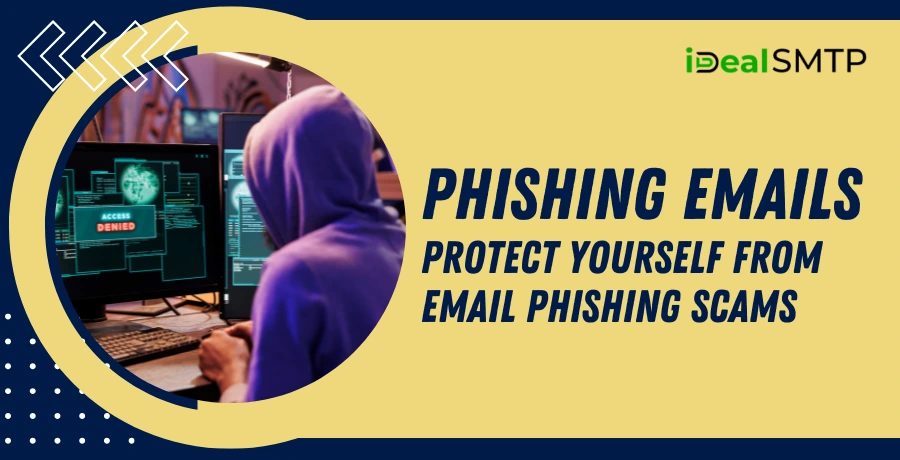Electronic communication depends heavily on email because it forms a central foundation within the digital sphere. Email’s wide adoption across all sectors makes it a prime target for cyber-attacks performed by criminals. Phishing emails which people refer to as Email Phish continue to be among the most frequent cyberattack methodologies. Selected targets need to hand in important information produced as login credentials and financial details.

This article takes a deep look into email phishing techniques while providing detection methods to prevent artificial attack success.
Table of Contents
Pricing
| Trail Plan | Standard Plan | Premium Plan | Professional Plan |
| $50 | $145 | $185 | $225 |
| Sending Limit | Sending Limit | Sending Limit | Sending Limit |
| 1000 Emails/Hour | 1500 Emails/Hour | 3000 Emails/Hour | 5000 Emails/Hour |
What is a Phishing Email?
Emails designed to deceive recipients use fraudulent messages duplicating messaging from legitimate origins including banks firms and work colleagues. The messages sent by phishers attempt to deceive people by requiring recipients to open harmful web links and malware or hand over private information. Year-over-year phishing techniques employed in email scams have evolved considerably rendering these attacks more challenging to identify.
Common Characteristics of Phishing Emails
- Urgent Language- Phishing emails often create a sense of urgency, such as “Your account will be suspended unless you act now.”
- Generic Greetings- Instead of addressing recipients by name, these emails might use vague terms like “Dear Customer.”
- Suspicious Links- Hyperlinks in phishing emails may lead to fraudulent websites. Hovering over the link usually reveals a URL that doesn’t match the claimed source.
- Unusual Attachments- Attachments in phishing emails may contain malware designed to infect your device.
- Poor Grammar and Spelling- Many phishing emails have noticeable errors, which can be a red flag.
Common Types of Email Phishing Scams
- Spear Phishing- Targeted attacks tailored to a specific individual or organization.
- Clone Phishing- Replicas of legitimate emails with malicious links or attachments.
- Whaling- High-level attacks targeting executives or decision-makers.
- Smishing and Vishing- Phishing via SMS (smishing) or voice calls (vishing).
Why Phishing Emails Are Effective
Phishing emails exploit human psychological reactions to gain success in their attacks. The messages create emotions that require quick responses from individuals. A standard phishing email scam pretends that your bank security has failed and commands you to “verify your details instantly.”
Phishing Email Detection: Signs to Watch For
Detecting phishing emails can be challenging, but being aware of red flags can significantly reduce your risk:

- Unusual Sender Addresses- The domain of the email sender should match the actual official domain of the sender entity.
- Generic Greetings- Emails from legitimate sources identify you separately from others by name in the greeting.
- Spelling and Grammar Errors- Typical phishing email communications offer several misspellings along with poor grammar and flow.
- Urgent Language- Fast-track pressure through email content should alert you to potential phishing attempts.
- Suspicious Links or Attachments- Before you choose to click a hyperlink you should pass your mouse over it to check where it directs you.
Phishing Email Analysis: How Experts Combat Scams
Members of the cybersecurity profession examine phishing threats by implementing complex analytical approaches and methods. The analysis consists of header verification for authentication and link destination assessment and threat detection through machine learning algorithms. Email marketing service providers exist to shield organizations’ communications using built-in phishing protection features.
How to Protect Yourself from Phishing Emails
Enable Multi-Factor Authentication (MFA). Multiple security levels must be added to your accounts for protection.
- Educate Yourself and Others- Update your knowledge about email phishing scams regularly.
- Use Email Filtering Tools- A variety of email marketing services include spam and phishing detection functions.
- Verify Requests- Sensitive requests need confirmation through a second channel of communication.
- Report Suspicious Emails- If you encounter suspicious emails seek assistance from your IT team by reporting through your email client tool.
Steps to Take if You Suspect Phishing
- Do Not Click or Respond- Avoid interacting with the email until you confirm its legitimacy.
- Report the Email- Notify your IT department or email provider.
- Scan Your Device- Use antivirus software to check for malware.
- Change Compromised Passwords- Update passwords immediately if you suspect unauthorized access.
Role of Email Marketing Services in Phishing Prevention
Mature email marketing services make security their fundamental priority. The security infrastructure at reputable email marketing service providers combines three protocols SPF, DKIM, and DMARC to reduce email spoofing incidents for clients. The services conduct activity monitoring to detect indicates of phishing scams while protecting your brand from attacks.
Conclusion
Phishing emails remain one of the most dangerous online threats in our digital age. Understanding their tactics will help you maintain vigilance that defends your organization and yourself against deceptive scams. The implementation of secure email marketing services together with proper preventive measures against phishing emails represents fundamental requirements to establish a defensive system.
You can defend yourself best against phishing email scams when you maintain strong suspicion alongside careful actions. Users who stay informed about phishing continue secure from email phishing tactics.







